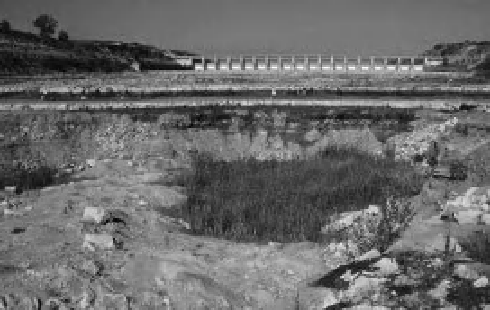Geoscience Reference
In-Depth Information
Figure 4-19.
Tourists visit Wieliczka salt mine, near
Kraków, Poland. The underground cathedral was
carved from within a chamber of the salt mine; the
chandeliers and other decorations also are made of
crystalline salt. This salt mine has been worked since
Medieval times and is still active; it is designated as a
World Heritage site. Photo by J.S. Aber.
Figure 4-17.
Tuttle Creek Lake on the Big Blue River
at Manhattan, Kansas was forced to open its spillway
gates (background) to release water as the reservoir
threatened to overl ow the dam in July 1993. The
resulting downstream l ow excavated deeply into
bedrock, creating a series of plunge pools
(foreground). Note people for scale in the spillway
channel. Photo by J.S. Aber.
4.5 Hydrochemistry
Water chemistry is a rich and complex subject
involving both organic and inorganic aspects
that are affected by diverse natural processes
and human activities (e.g. McMurry, Castellion
and Ballantine 2007). Here we review several
factors of special importance for understanding
wetland hydrochemistry. Water contains dis-
solved solids in the form of ions
-
positively
charged cations and negatively charged anions.
Salt, the mineral halite (NaCl), is a simple
example (Fig. 4-19). As a dissolved solid, salt
exists as Na
+
cations and Cl
−
anions. Water solu-
tions typically contain many dozens of dissolved
solids, such that overall charges balance for elec-
trical neutrality. In addition, soluble organic
compounds and gases may dissolve into water.
Common gases in water include oxygen (O
2
),
carbon dioxide (CO
2
), methane (CH
4
), hydrogen
suli de (H
2
S), and helium (Fig. 4-20).
Water molecules naturally dissociate into H
+
and OH
−
ions:
Figure 4-18.
Little Arkansas River at Halstead in
south-central Kansas. The levee in the left background
was under construction, but not i nished, in 1993 when
l ooding devastated the city of Halstead on the other
side. The levee was subsequently completed and has
protected the city since. However, downstream l ooding
of unprotected cities has increased as a consequence.
Photo by J.S. Aber.
reservoirs had to release water to avoid being
overwhelmed (Fig. 4-17). Based on the outcome
of the 1993 l ooding, engineers and planners
are adopting new strategies for l ood manage-
ment, based on less artii cial control (dams and
levees) and more natural river behavior, namely
l oodplains and wetlands. In spite of this effort,
many levees have been constructed or rebuilt
(Fig. 4-18), which may lead to more damage in
the future (Welsch et al. 1995).
HO
= = +
+ −
Pure water at 25 °C contains 10
−
7
moles per liter
of H
+
ions. This is the basis of the pH scale;
neutral pH
HOH
H
OH
2
7 (inverse log of H
+
concentra-
tion). For acidic solutions with more H
+
, the pH
=








